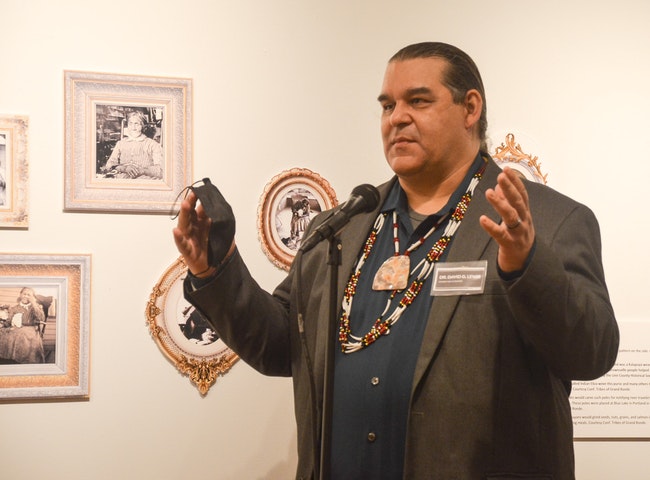David Lewis, anthropologist and curator of the Salem Art Association’s “Native Salem” exhibit, speaks at an opening reception on Nov. 11, 2021 (Rachel Alexander/Salem Reporter)
“Salem didn’t start with Jason Lee.”
That’s one takeaway David Lewis hopes visitors to the new “Native Salem” exhibit at the Salem Art Association will come away with.
Lewis is a member of the Confederated Tribes of Grand Ronde who managed the tribe’s cultural department for eight years and now teaches at Oregon State University.
He curated the exhibit, which chronicles the history of the Kalapuyans, Salem’s original inhabitants, and how their lives changed as settlers migrated to the Willamette Valley.
Speaking at a preview reception Thursday evening, Lewis said the histories of Salem taught in local schools and in the public sphere still too often begin with the Oregon Trail and early Methodist missionaries like Lee, leaving out the generations of Indigenous people who lived here first and aided early settlers in building homes.
“My tribal ancestors have lived in western Oregon for at least 16,000 years, and yet I see few representations of my people in this city,” Lewis wrote in a curator statement. “I was never taught about my people in the schools, and my children who attended many of the same schools, some 30 years later, also did not learn about their tribal ancestors, the histories or cultures of our tribes.”
The exhibit, housed in the upstairs gallery at the Bush Barn Art Center in Bush’s Pasture Park, combines large panels of text with historic photos to tell the story of life before colonization, including tribal fishing and food gathering practices, and woven baskets.
Three baskets on loan from the Hallie Ford Museum of Art show how Kalapuyan weavers changed styles, moving to larger baskets that were in demand from Euro-American settlers in the years following colonization.
Visitors can see a recent basket woven by master weaver Connie Graves. It’s made from rush fibers and rectangular, shaped like a small purse or shoulder bag.
There’s an option to scan a code with their phone to watch a video detailing the weaving process.
Lewis was born in 1965, a decade after the U.S. government terminated the Grand Ronde tribe. That meant the tribe lost federal recognition, the tribal council stopped meeting and many tribal members lost their land, which they suddenly had to pay taxes on. The tribe was restored in 1983.
Growing up, Lewis said he commonly heard people speak about Native Americans as if they were extinct or ceased to exist after being removed to reservations. Termination, he said, was the final step in the U.S. government’s efforts to wipe out Indigenous people and cultures, following the boarding school era when children were sent to schools where they weren’t allowed to speak their own languages or practice their own cultures.
“The government tried to erase us…so what do you expect?” he said. “We don’t exist, we didn’t exist.”
For him and other Indigenous people of his generation, he said that motivated him to learn more about his history.
“I’m like, ‘Wait a minute, I’m still here! Don’t I count?’” he said.
A public reception for the exhibit will be held Friday evening from 5:30-7:30 p.m., with Lewis on hand to answer questions. The exhibit runs through Dec. 24.
Admission to the Bush Barn Art Center, 600 Mission St. S.E., is free and open to the public Thursday through Saturday from 11 a.m. to 4 p.m.
Bob Tom, an elder with the Grand Ronde and Siletz tribes, said the exhibit, opening during Native American Heritage Month, is part of a growing recognition of Indigenous people and their lives and cultures in the region. He mentioned the recent Indigenous Peoples Day celebration in Salem Oct. 11, where young people joined elders to dance under an amphitheater shaped like a Kalapuyan basket.
“Though it was one day and this is one month, every opportunity to where our youth can celebrate who they are, learn a little about who they are…those things are important,” he said. “A lot of good things are happening.”
Contact reporter Rachel Alexander: [email protected] or 503-575-1241.
JUST THE FACTS, FOR SALEM – We report on your community with care and depth, fairness and accuracy. Get local news that matters to you. Subscribe to Salem Reporter starting at $5 a month. Click I want to subscribe!

Rachel Alexander is Salem Reporter’s managing editor. She joined Salem Reporter when it was founded in 2018 and covers city news, education, nonprofits and a little bit of everything else. She’s been a journalist in Oregon and Washington for a decade. Outside of work, she’s a skater and board member with Salem’s Cherry City Roller Derby and can often be found with her nose buried in a book.









